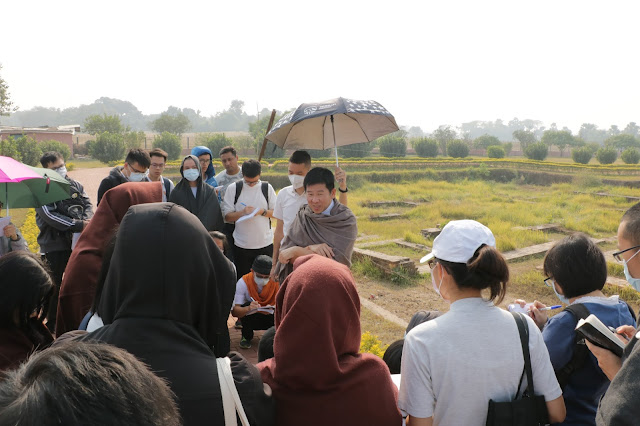Passing by Patna (ancient: Pataligama) and crossing the misty and mighty river of Ganga, we travelled to Vaishali on the 6th day. Vaishali was known as Vesali in the past. Vesali was the headquarters of the Licchavis or Vajjis whom formed in confederation of eight clans. The Buddha once taught the Vajjians the seven conditions leading to welfare at the Sarandada shrine, making them unified and strong, even against King Ajattasattu of the Magadha kingdom. However, their unity was weakened due to the treachery plan made by King Ajattasattu by sending his brahmin, Vassakara to sow discord among the Vajjians, resulting in the breaking of the seven welfare conditions. Upon weakened, King Ajattasattu attacked the Vajjians and gained control over Vesali, causing the downfall of the Vajjis. The famous Ratana Sutta or the Jewel Discourse (Sn 2.1) was expounded here in Vesali as a protection to the city when Vesali was plagued with famine, diseases and evil spirits due to a severe drought. The first establishment of Bhikkhuni Sangha was happened here in Vesali, lead by Maha Pajapati Gotami. Vesali also marks the place where the first schism happened between Vajjian monks and other Sangha order, leading to the Second Rehearsal and formation of Mahayana and Theravada divisions. This is due to the breaching of the ten point practice in Vinaya rules by the Vajjian monks.
Raj Vishal ka Garh
This site, also known as the ancient Fort Licchavis, is believed to be the citadel of the Vajjian confederacy where they came together and have meetings. The Vajjians hold frequent meetings as advised by Lord Buddha in one of the seven conditions leading to welfare. The seven conditions leading to welfare was told to brahmin Vassakara of the Magadha kingdom by Lord Buddha through an question-answer interaction with Ven. Ananda.
 |
| Bro Tan sharing about the fate of Vajjians in the ancient Fort Licchavis |
Kolhua
Located in Kolhua is the impressive Asokan Pillar with the lion statue facing the 4.6m-high dome-shaped Asoka, surrounded by a number of votive stupas. Just nearby the pillar and stupa is the monkey's tank or Rama-kunda, believe to be dug by a colony of monkeys for the use by Lord Buddha. It's believed that this is the spot where the offering of honey by the monkeys to Lord Buddha happened.
Licchavis Stupa
Here locates the remains of the Licchavis stupa, erected by the Licchavis to enshrine the relics of Lord Buddha. The stupa was later excavated by King Asoka for the relics and redistributed. When the stupa was being excavated again by archaeologists in the mid of 20th century, only a relic casket made of soapstone was found, with ashy earth, a piece of gold leaf, glass beads, small conch and coin contained inside. Here, Bro Tan shared about the plagues that had attacked this city and how the Ratana Sutta came about. We recited the sutta to end our visit in Vesali for the day.
 |
| Licchavis Stupa enclosed with dome-shaped roof |
 |
| The remains of Licchavis Stupa |
Before we visit the stupa, we paid a short visit to a school located just beside the site of the stupa. Unlike us here in Malaysia, the students there has to attend lessons under the open-environment classroom. I reflected how we're lucky to have such a comfy environment to study back in Malaysia. Here, we distributed the stationery and biscuits to the students as an encouragement for them to study well and get educated.



No comments:
Post a Comment